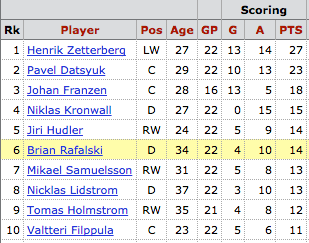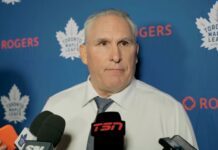IN WHICH BRENDAN SHANAHAN REVERSES THE CURSE OF HAROLD BALLARD
So, back when Brendan Shanahan hired Mark Hunter from London and Kyle Dubas from the Sault and Jim Paliafito and Lindsay Hofford and then the rest of the OHL, I admit — I figured the Leafs had given up on ever getting any high-end European or Russian players, and it was just going to be more of the usual.
Boy, was I wrong.
Because the next thing Shanahan did was go out and hire two of the most pro-European executives in NHL history.
Setting the stage for the Leafs to bring least 12 new high-end Europeans and Russians on-board.
It is something I did not see coming. At all.
Given that former Leaf chief Harold Ballard hated Russians and despised Europeans, Shanahan may well have started a reversal of the old man’s curse.
So let’s take a look at these two new hires.
***
Obviously, Mike Babcock meets Brendan Shanahan’s number one job requirement — namely, he’s a top puck possession coach. After all, this was the guy who inherited the torch from Scotty Bowman in Detroit, and won a Cup with it.
Now, Babcock is best known to most Canadians for coaching Team Canada to Olympic Gold in 2010 and 2014. He’s a man who knows Canadian hockey, knows Canadian talent, and knows how to make it perform.
But, as an NHL coach, Babcock turns out to be the furthest thing there is from a narrow Canadian nationalist. In fact, it’s hard to overstate just how open Mike Babcock is to playing Russians and Europeans.
Let me put it this way.
Each of Mike Babcock’s ten Detroit teams dressed 12 to 17 Europeans per season.
And he doesn’t just play them in bottom-minute roles. Take the 2007-08 Stanley Cup team, where nine out of his top 10 playoff scorers were European. Zetterberg won the Conn Smythe; Lidstrom became the first European to Captain a Cup-winning team:
 Even in Anaheim, Babcock played 13 to 16 Europeans per year [and this is out of an average team’s roster of 30-35 players per season].
Even in Anaheim, Babcock played 13 to 16 Europeans per year [and this is out of an average team’s roster of 30-35 players per season].
Silver Bullet: Every Mike Babcock team has seen him play 12 to 17 Europeans.
[Note: As roster selection decisions are increasingly shared between coach and GM in the modern NHL, we’ll look at the new Leafs coach here, followed by the new GM below].
***
Now imagine a team where Mike Babcock was replaced by Randy Carlyle.
Because that actually happened.
In 2003-04, Babcock coached Anaheim [Bryan Murray GM], and dressed 16 Europeans. But when Babcock left for Detroit, Randy Carlyle [and GM Brian Burke] came in.
Carlyle and Burke took the 16 Europeans of Mike Babcock’s Anaheim and moved them until there were just nine remaining, and then, eventually, just three.
Now, let’s be clear: Carlyle and Burke won a Cup with their preferred mix. You absolutely can win without playing Europeans.
But cutting 16 Europeans to three wasn’t an accident.
Most often these days, the mix of nationalities on a team is simply the byproduct of the style of game that a coach and GM prefer. For example, a Carlyle/Burke team will hit and fight, and tend to shed Europeans. And sure, Randy Carlyle may have been somewhat uncomfortable with European and Russian players.
After all, this was a man who had a helluva time communicating with a toaster.
When even the average Finn has more moving parts than a toaster.
Turning to the flip-side, a Scotty Bowman or Mike Babcock team will prefer a puck possession game, and will almost certainly add Europeans. Or a Pat Quinn, who spent years getting Larionov and Krutov, Bure and Mogilny for Vancouver.
Once in Toronto, Quinn’s pro-European stance grew even stronger, and he played as many as 14 a year, including Sundin, Mogilny, Kaberle, Yushkevich, and Danny Markov.
But then Burke and Carlyle arrived. Just as in Anaheim, the Europeans were shown the exits, from Stralman through to Grabovski. While I didn’t mind the Leafs sending some of these guys out, they were never replaced.
No young Europeans or Russians were added [check out the 2009-12 Leaf drafts].
By comparison, that same year – just down the 401 in Detroit – Babcock and Holland were playing 17 Europeans, including their seven top scorers.
Toronto vs. Detroit, European Comparison -- 2013-14
| TORONTO | GP | DETROIT | GP |
|---|---|---|---|
| Nik Kulemin | 70 | Daniel Alfredsson | 68 |
| Carl Gunnarsson | 80 | Niklas Kronwall | 79 |
| Petter Granberg | 1 | Gustav Nyquist | 57 |
| Henrik Zetterberg | 45 | ||
| Johan Franzen | 54 | ||
| Tomas Tatar | 73 | ||
| Pavel Datsyuk | 45 | ||
| Jakub Kindl | 66 | ||
| Joakim Andersson | 65 | ||
| Tomas Jurco | 36 | ||
| Jonathan Ericsson | 48 | ||
| Mikael Sameulsson | 26 | ||
| Adam Almqvist | 2 | ||
| Alexei Marchenko | 1 | ||
| Teemu Pulkkinen | 3 | ||
| Jonas Gustavsson | 27 | ||
| Peter Mrazek | 9 | ||
| 3 Europeans | 151 | 17 Europeans | 704 |
To repeat, that’s 17 on Babcock’s Wings versus three on Carlyle’s Leafs.
Those stark differences – and that scale of change – don’t happen by accident.
And it’s about to happen again in Toronto.
Only this time, in reverse, with Randy Carlyle being replaced by Mike Babcock.
So Mike Babcock isn’t just a great puck possession coach. He’s also very comfortable with, and perhaps even committed to, having European players on his roster and playing them. They fit his preferred puck possession style. He’s comfortable with them.
He’s always played at least a dozen on his roster, and he’s had great success with it.
So if Babcock has any say in it, he’ll likely push that number up over time.
Adding a dozen European and Russian players to the roster would absolutely be one of the most visible changes we’d see in the new Leafs.
Okay. Now let’s look at the new GM’s side.
***
Wherein: Lou lets a buncha commies into America [DAMMIT LOU!!]
When rookie GM Lou Lamoriello came to an awful New Jersey franchise in 1987, he decided to identify the number one thing he could do to improve his team.
Lou’s choice of Job #1?
Get Slava Fetisov.
That is, get him out of the Soviet Union, a country from which no top hockey player had ever escaped.
Mordor wished it had been that tight.
U.S. media focus was intense. Unfortunately for Lamoriello, getting Fetisov turned out to be incredibly time-consuming. Now, other GMs were also working to this end, such as Pat Quinn, who was trying to get Larionov and Krutov out.
But Fetisov was the big sturgeon, and he decided that he didn’t want to defect. He wanted to use his name to create a legal route out for all the younger Russians. A principled stand, but it meant Lou faced the hardest negotiating task.
Of course, Lou’s negotiations had to navigate the political hurricanes. The rise of Solidarity in Poland. The Velvet Revolution in Czechoslovakia. The fall of the Berlin Wall.
And so on, in an endless cycle of calls, meetings and flights, and with hopes rising and falling with every event. Until finally, in June 1989 — after two full years of applied grit, skill and patience — Lou Lamoriello got to stand alongside Job #1.
Slava Fetisov.
The entire effort was high-profile and high-pressure, but it also became one of the biggest, game-changing moves in the history of the NHL.
How game-changing? Well, for starters, the NHL was at absolute zero when it came to the Russians. Let’s take 1987, when Lou began his work to get Fetisov.
1. There were precisely 0 [that’d be “zero”] Russians in the NHL.
2. At the 1987 Entry Draft that Summer, Brendan Shanahan of the London Knights was chosen #2 overall, by Lou Lamoriello’s very own New Jersey Devils. Given the sense of style we all had in 1987 – below – you can see why that was a great call.
Fashion Wookie – Night Before 1987 Draft:
1987- night before my NHL Draft. My high school friends came to support. #nobeerforme #nervous #shirt?? #karenstock pic.twitter.com/ArgbRLWnQD
— Brendan Shanahan (@brendanshanahan) August 27, 2015
But the 1987 draft had one other notable feature:
Every single player picked in the 1st Round was from Canada.
No Russians, no Czechs, no Swedes or Finns. Not even an American.
Which may have been a partial reaction to the World Juniors that year, where the Fashion Wookie had strapped on his armour, then gone out and pounded the piestany out of a couple of Russian kids in a darkened arena.
Remember? How our pal Shanahan’s first big televised game turned into an international incident, as he and his Canadian teammates fought a bunch of Russians that nobody would ever remember anyway [Fedorov? Konstantinov? Mogilny?]?
Ending with Shanahan and the Canadians being removed from the arena at gunpoint — by soldiers — and driven to the border under military guard.
It was an astonishing moment, perhaps crowned by the Leafs’ own Harold Ballard having medals minted for and awarded to the Canadian kids, Shanahan included.
But, in the bigger picture, Piestany gives a sense of the kind of opposition Lamoriello faced, with the polls showing 92% of Canadians [me included] supporting our kids.
92% in a poll is good and all, but it’s the kind of support you only see during wars. Which makes sense, because Canada versus Russia in hockey was basically our Cold War.
And Lou’s job was to go directly against that. Not easy.
Now let’s see his impact.
***
Silver Bullet: In the ten years after Lamoriello and Fetisov, the number of Soviets in the NHL grew from 0 to 84.
By vastly increasing attention on Europe as a whole [e.g. in 1989, Mats Sundin became the first European drafted #1 overall], almost 250 Europeans joined the league.
[visualizer id=”50204″]
Now, 250 is a lot of hockey players — enough to fill 10 NHL rosters.
And — you’ll be surprised by this next part — the NHL owners performed this same complex math, calculated the number of new teams that could be supported, multiplied that by the media revenues and expansion fees, and… voila!
They expanded the NHL from 21 to 30 teams.
So if you don’t like the NHL having teams in Florida…
Blame Lou Lamoriello.
Now, fortunately for hockey fans, this enormous wave of European players included some incredible new talent — Sundin, Mogilny, Jagr, Teemu, Ovie, Pavel, Lidstrom, Hasek, and many more.
Like it or loathe it, this was an NHL transformed. And on the NHL’s end, the transformer was named Lou Lamoriello.
***
Wherein: Harold Ballard does a barrel roll in hell [DAMMIT HAL!]
Perversely, Lamoriello didn’t just face opposition from the Soviets, but from [what he called] “paranoid” NHL owners and executives.
Like Chief Leaf Harold Ballard, a man whose hatred and distaste for Russians [and Europeans] was enough to hold the Leafs back for decades. And who loved to tell the story about how, when he visited Lenin’s Tomb in Moscow, he pissed on it.
Then stuck a Leafs sticker on it.
Pal Hal. Amazing that he’d end up with his own grave less than well-treated, eh?
Anyway, from the NHL’s perspective, Lou was a God-send. He helped them access hundreds of new players and allowed the league to expand by 50%.
Which may help to explain why, 20 years later, when Lou was inducted into the HHOF, Gary Bettman called him a “visionary” — a man with the foresight to see that all those “highly-talented hockey players in the former Soviet Union could have a place in this league.”
Of course, Lou had much greater aspirations than landing Fetisov and Kasatonov. He wanted to create a “family” on his teams. Part of that was to have players from every nation – Mogilny and Kovalchuk, Brodeur and Niedermayer, Rafalski, Holik and Elias. And okay, fine, while his pro-global “family” approach may not have been beloved by every player, he did take over an abysmal franchise and went on to win three Cups.
That 2013-14 season we looked at? Lou had 12 Europeans and Russians. Not two.
While Lou may not have been as much into puck possession as Babcock or Shanny, he still stands as one of the best GMs at knowing how to pull players out of Russia and Europe.
***
Now let’s put the Shanahan, Babcock and Lamoriello team together.
Each has long and successful experience with European players. They have great networks there. They’re comfortable with European talent and have no hesitation in playing it.
So, step-by-step, Brendan Shanahan is reversing the curse of Harold Ballard, as Ballard does a barrel roll in hell.
But now imagine dropping these three pro-European executives onto a Leaf team that had been emptied of Europeans and had almost no European prospects.
The Europeans are coming, folks. And the Russians, too. Shanahan’s team is going to make Toronto a comfortable, and attractive, place for them.
Now, obviously, the numbers of Europeans won’t jump from two to 12 immediately, because this year’s Leaf roster is 90% trade bait.
But over the next 2-4 years — and especially as the young talent comes up — there’s no reason to believe we won’t see the Leafs adding at least the 12 Russians and Europeans Babcock is accustomed to.
As we always knew, Shanahan’s ‘New Generation Leafs’ are going to have an awful lot of speed and skill when they hit the ice.
And a lot of it is going to come with European and Russian names across the back.
***
Footnote: I often prefer to refer to “Europeans and Russians,” rather than lumping them all together as “Europeans.” I do this mostly because some of Brendan Shanahan’s most powerful personal moments are tied to Russian players – the 1987 brawl in Piestany… having Slava Fetisov and the first Soviets land in his New Jersey dressing room… learning puck possession from the Russian 5 in Detroit… and the tragedy that later impacted that team. References to “Russia and the Region” simply mean Russia plus the nations of the Former Soviet Union – i.e. the Ukraine, Belarus, Kazakhstan, Latvia, Estonia, etc.
Read the rest of the series here:
- Brendan Shanahan gets “puck possessed” – Part I
- Reversing the curse – Part II
- Shanny listens to his Leaf gut – Part III
- Nylander, Kapanen and Shanny’s Fancy Foreign Friends – Part IV
- Shanahan and Soshnikov – The Kid Who’s Scared of Nothing – Part V
- Nikita Zaitsev: Part of the new Maple Leaf Russian 5? Part VI
- Brendan Shanahan: He’s Changed – Part VII















![John Gruden after the Leafs prospects’ 4-1 win over Montreal: “[Vyacheslav Peksa] looked really comfortable in the net… We wouldn’t have won without him” John Gruden, head coach of the Toronto Marlies](https://mapleleafshotstove.com/wp-content/uploads/2025/09/gruden-post-game-sep-14-218x150.jpg)


















